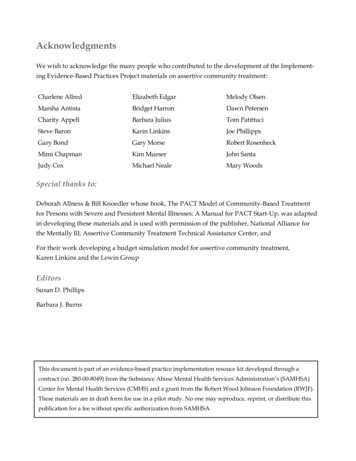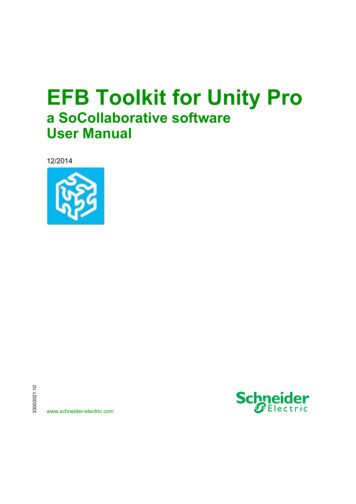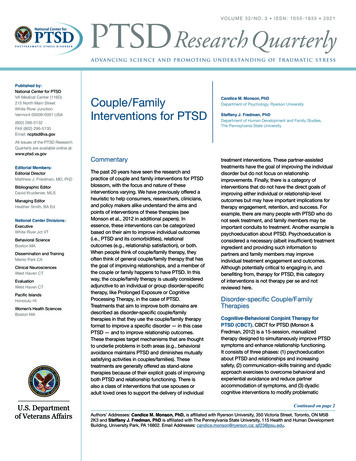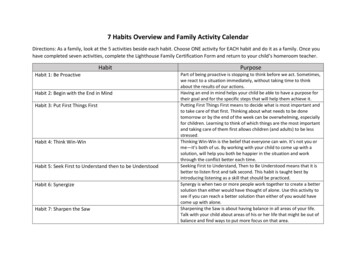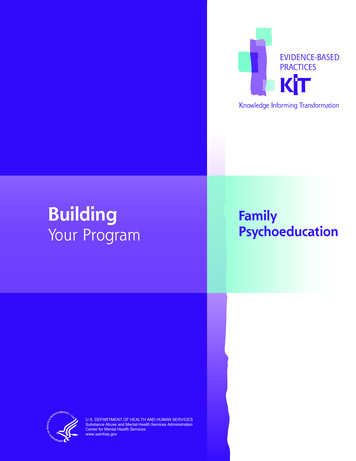
Transcription
BuildingYour ProgramU.S. DEPARTMENT OF HEALTH AND HUMAN SERVICESSubstance Abuse and Mental Health Services AdministrationCenter for Mental Health Serviceswww.samhsa.govFamilyPsychoeducation
BuildingYour ProgramU.S. Department of Health and Human ServicesSubstance Abuse and Mental Health Services AdministrationCenter for Mental Health ServicesFamilyPsychoeducation
AcknowledgmentsThis document was prepared for the Substance Abuse and Mental Health Services Administration(SAMHSA) by the New Hampshire-Dartmouth Psychiatric Research Center under contract number280-00-8049 and Westat under contract number 270-03-6005, with SAMHSA, U.S. Departmentof Health and Human Services (HHS). Neal Brown, M.P.A., and Crystal Blyler, Ph.D., served asthe Government Project Officers.DisclaimerThe views, opinions, and content of this publication are those of the authors and contributors anddo not necessarily reflect the views, opinions, or policies of the Center for Mental Health Services(CMHS), SAMHSA, or HHS.Public Domain NoticeAll material appearing in this document is in the public domain and may be reproducedor copied without permission from SAMHSA. Citation of the source is appreciated. However,this publication may not be reproduced or distributed for a fee without the specific, writtenauthorization from the Office of Communications, SAMHSA, HHS.Electronic Access and Copies of PublicationThis publication may be downloaded or ordered at http://www.samhsa.gov/shin. Or, pleasecall SAMHSA’s Health Information Network at 1-877-SAMHSA-7 (1-877-726-4727) (Englishand Español).Recommended CitationSubstance Abuse and Mental Health Services Administration. Family Psychoeducation: BuildingYour Program. HHS Pub. No. SMA-09-4422, Rockville, MD: Center for Mental Health Services,Substance Abuse and Mental Health Services Administration, U.S. Department of Health andHuman Services, 2009.Originating OfficeCenter for Mental Health ServicesSubstance Abuse and Mental Health Services Administration1 Choke Cherry RoadRockville, MD 20857HHS Publication No. SMA-09-4422Printed 2009
Building Your ProgramBuilding Your Program is intended to help mental healthauthorities, agency administrators, and family interventioncoordinators think through and develop the structure ofFamily Psychoeducation programs. The first part of thisbooklet gives you background information about theevidence-based model. This section is followed by specificinformation about your role in implementing and sustainingyour program. Although you will work closely togetherto build your program, for ease, we separated tips intotwo sections:n Tips for Mental Health Authorities; andn T ips for Agency Administrators and FamilyIntervention Coordinators.In preparing this information, we could think of no one betterto advise you than people who have worked successfullywith Family Psychoeducation programs. Therefore, we basedthe information in this booklet on the experience of veteranfamily intervention coordinators and administrators.For references, see the booklet The Evidence.FamilyPsychoeducation
This KIT is part of a series of Evidence-Based Practices KITs createdby the Center for Mental Health Services, Substance Abuse andMental Health Services Administration, U.S. Department of Healthand Human Services.This booklet is part of the Family Psychoeducation KIT that includesa DVD, CD-ROM, and seven booklets:How to Use the Evidence-Based Practices KITsGetting Started with Evidence-Based PracticesBuilding Your ProgramTraining Frontline StaffEvaluating Your ProgramThe EvidenceUsing Multimedia to Introduce Your EBP
What’s in Building Your ProgramWhat Is Family Psychoeducation?. . . . . . . . . . . . . . . . . 1Tips for Mental Health Authorities . . . . . . . . . . . . . . . . 9 ips for Agency AdministratorsTand Family Intervention Coordinators. . . . . . . . . . . . . . 19FamilyPsychoeducation
Building Your ProgramWhat Is Family Psychoeducation?Family Psychoeducation (FPE) is anapproach for partnering with consumersand families to treat serious mentalillnesses. FPE practitioners developa working alliance with consumersand families.The term psychoeducation can bemisleading. While FPE includes manyworking elements, it is not family therapy.Instead, it is nearly the opposite. In familytherapy, the family itself is the object oftreatment. But in the FPE approach,the illness is the object of treatment, notthe family. The goal is that practitioners,consumers, and families work togetherto support recovery.Building Your Program1Serious mental illnesses such asschizophrenia, bipolar disorder, andmajor depression are widely acceptedin the medical field as illnesses with wellestablished symptoms and treatment.As with other disorders such as diabetesor hypertension, it is both honest anduseful to give people practical informationabout their mental illnesses, how commonthey are, and how they can manage them.What Is Family Psychoeducation?
Many consumers and families report that thisinformation is helpful because it lets them knowthat they are not alone and it empowers them toparticipate fully in the recovery process. Similarly,research shows that consumer outcomes improveif families receive information and support (Dixonet al., 2001). For this reason, a number of familypsychoeducation programs have been developedover the past two decades.The phases of FamilyPsychoeducationFPE services are provided in three phases:n Joining sessions;n An educational workshop; andn Ongoing FPE sessions.Models differ in their format (whether theyuse a multifamily or single-family format);duration of treatment; consumer participation;and location. Research shows that the criticalingredients of effective FPE include the following(Dixon et al., 2001):Joining sessionsInitially, FPE practitioners meet with consumersand their respective family members in introductorymeetings called joining sessions. The purpose ofthese sessions is to learn about their experienceswith mental illnesses, their strengths and resources,and their goals for treatment.n Education about serious mental illnesses;n Information resources, especially during periodsof crises;n Skills training and ongoing guidance aboutFPE practitioners engage consumers and familiesin a working alliance by showing respect, buildingtrust, and offering concrete help. This workingalliance is the foundation of FPE services. Joiningsessions are considered the first phase of theFPE program.managing mental illnesses;n Problem solving; andn Social and emotional support.What Is Family Psychoeducation?2Building Your Program
Educational workshopOngoing FPE sessions focus on current issues thatconsumers and families face and address themthrough a structured problem-solving approach.This approach helps consumers and families makegains in working toward consumers’ personalrecovery goals.In the second phase of the FPE program, FPEpractitioners offer a 1-day educational workshop.The workshop is based on a standardizededucational curriculum to meet the distincteducational needs of family members.FPE is not a short-term intervention. Studiesshow that offering fewer than 10 sessions does notproduce the same positive outcomes (Cuijpers,1999). We currently recommend providing FPEfor 9 months or more.FPE practitioners also respond to the individualneeds of consumers and families throughoutthe FPE program by providing information andresources. To keep consumers and families engagedin the FPE program, it is important to tailoreducation to meet consumer and family needs,especially in times of crisis.In summary, FPE practitioners provide informationabout mental illnesses and help consumersand families enhance their problem-solving,communication, and coping skills. When providedin the multifamily group format, ongoing FPEsessions also help consumers and families developsocial supports.Ongoing Family Psychoeducation sessionsAfter completing the joining sessions and 1-dayworkshop, FPE practitioners ask consumers andfamilies to attend ongoing FPE sessions. Whenpossible, practitioners offer ongoing FPE sessionsin a multifamily group format. Consumers andfamilies who attend multifamily groups benefitby connecting with others who have similarexperiences. The peer support and mutual aidprovided in the group builds social supportnetworks for consumers and families who are oftensocially isolated.Building Your ProgramPractice principlesFPE is based on a core set of practice principles.These principles form the foundation of theevidence-based practice and guide practitionersin delivering effective FPE services.3What Is Family Psychoeducation?
Practice PrinciplesPrinciple 1:Consumers definewho family is.Principle 2:The practitioner-consumer-familyalliance is essential.Principle 3:Education and resources helpfamilies support consumers’personal recovery goals.Principle 4:Consumers and families whoreceive ongoing guidance andskills training are better able tomanage mental illnesses.In FPE, the term family includes anyone consumers identify as beingsupportive in the recovery process. For FPE to work, consumers mustidentify supportive people they would like to involve in the FPE program.Some consumers may choose a relative. Others may identify a friend,employer, colleague, counselor, or other supportive person.Consumers and families have often responded to serious mental illnesseswith great resolve and resilience. FPE recognizes consumer and familystrengths, experience, and expertise in living with serious mental illnesses.FPE is based on a consumer-family-practitioner alliance. When formingalliances with consumers and families, FPE practitioners emphasize thatconsumers and families are not to blame for serious mental illnesses. FPEpractitioners partner with consumers and families to better understandconsumers and support their personal recovery goals.Consumers benefit when family members are educated about mentalillnesses. Educated families are better able to identify symptoms, recognizewarning signs of relapse, support treatment goals, and promote recovery.Provide information resources to consumers and families, especially duringtimes of acute psychiatric episodes or crisis.Consumers and families experience stress in many forms in response tomental illnesses. Practical issues such as obtaining services and managingsymptoms daily are stressors. Learning techniques to reduce stressand improve communication and coping skills can strengthen familyrelationships and promote recovery. Learning how to recognize precipitatingfactors and prodromal symptoms can help prevent relapses. For moreinformation, see Training Frontline Staff in this KIT.Principle 5:Problem solving helps consumersand families define and addresscurrent issues.Principle 6:Social and emotional supportvalidates experiences andfacilitates problem solving.What Is Family Psychoeducation?Using a structured problem-solving approach helps consumers and familiesbreak complicated issues into small, manageable steps that they may moreeasily address. This approach helps consumers take steps toward achievingtheir personal recovery goals.FPE allows consumers and families to share their experiences and feelings.Social and emotional support lets consumers and families know that theyare not alone. Participants in FPE often find relief when they openly discussand problem-solve the issues that they face.4Building Your Program
How we know that FamilyPsychoeducation is effectiveWho benefits most from FamilyPsychoeducation?FPE is based on research that shows thatconsumers and families who participated in thecomponents of the evidence-based model had 20to 50 percent fewer relapses and rehospitalizationsthan those who received standard individualservices over 2 years (Penn & Mueser, 1996; Dixon& Lehman, 1995; Lam, Knipers, & Leff, 1993;Falloon et al., 1999). Those at the higher end of thisrange participated for more than 3 months.The greatest amount of research has shown benefitsfor consumers with schizophrenic disorders andtheir families (Dixon et al., 2001). Studies also showpromising results for the following illnesses:Studies also show that FPE improved family wellbeing (Dixon et al., 2001). Families reported agreater knowledge of serious mental illnesses;a decrease in feeling confused, stressed, andisolated; and reduced medical illnesses and useof medical care (Dyck, Hendryx, Short, Voss, &McFarlane, 2002).n Major depression—(Simoneau et al., 1999;FPE has been found to increase consumers’participation in vocational rehabilitation programs(Falloon & Pederson, 1985). Studies have shownemployment rate gains of two to four times baselinelevels, when combined with evidence-basedpractice Supported Employment (McFarlane,Dushay, Stastny, Deakins, & Link, 1996; McFarlaneet al., 1995; McFarlane et al., 2000).Studies show that the effectiveness of FPE doesnot differ depending on consumers’ age, gender,education-level, or severity of illness.Based on this significant evidence, treatmentguidelines recommend involving families inthe treatment process by offering the criticalingredients outlined in this evidence-based model(Lehman & Steinwachs, 1998; American PsychiatricAssociation, 1997; Weiden, Scheifler, McEvoy,Allen, & Ross., 1999).n England—(Leff, Kuipers, Berkowitz, & Sturgeon,n Bipolar disorder—(Clarkin, Carpenter, Hull,Wilner, & Glick, 1998; Miklowitz & Goldstein,1997; Moltz, 1993; Parikh et al., 1997; Miklowitzet al., 2000; Simoneau, Miklowitz, Richards,Saleem, & George, 1999);Emanuels-Zuurveen & Emmelkamp, 1997; Leffet al., 2000);n Obsessive-compulsive disorder—(Van Noppen,1999); andn Borderline personality disorder—(Gunderson,Berkowitz, & Ruizsancho,, 1997).This model has also been adapted and usedeffectively with a number of ethnic groups in avariety of settings in the United States. Studies havealso been conducted in the following countries:1985; Leff et al., 1990; Tarrier et al., 1989);n Spain—(Muela Martinez & Godoy Garcia, 2001;Montero, Gomez-Beneyto, Ruiz, Puche, &Adam, 1992; Tomaras et al., 2000);n Germany—(Wiedemann et al., 2001); andn China—(Xiong et al., 1994; Zhang, Wan, Li, &Phillips, 1994).Building Your Program5What Is Family Psychoeducation?
Although more replications are desirable, all theevidence to date suggests that the positive effectsof FPE generalize to nearly all major culturalpopulations: British, American, Australian, AfricanAmerican, Spanish or Latino, Scandinavianor Northern European, Chinese, and Japanese.However, anecdotally we know that culture andlanguage pose significant barriers to providingFPE in some populations and, in any case, requireculturally sensitive adaptations that must be furtherexplored empirically.Research shows that practitioners often askconsumers for permission to involve their familymembers during a crisis (Marshall & Solomon,2003). Asking for family involvement at thistime may raise suspicions for some consumers.Consequently, they may be more reluctantto identify supportive people. For this reason,modify your intake and assessment proceduresso that consumers are routinely told about the FPEprogram and are periodically asked if they would liketo involve someone supportive in their treatment.For more detail, see Set up referral proceduresunder Tips for Agency Administrators and FamilyIntervention Coordinators in this booklet.I s Family Psychoeducation for the family’sbenefit or for the consumer’s?If consumers do not wish to involve familymembers in their treatment, FPE practitionersshould respect their decision. If consumers do notgive permission to share confidential informationwith their families, FPE practitioners may stillrespond to families’ questions and concerns.Even the strictest interpretation of confidentialitypolicies does not prohibit receiving informationfrom families or giving them general informationabout serious mental illnesses and agency services(Bogart & Solomon, 1999; Zipple, Langle, Spaniol,& Fisher, 1997).FPE is for both consumers and families. Thegoal is to support recovery from serious mentalillnesses. The evidence-based model asks familymembers to help in that effort. Though it isdesigned to achieve clinical outcomes and recoverygoals for consumers, beneficial effects have beenfound for families as well. hat if consumers do not have familyWor do not want their families involved?If families want to learn more about serious mentalillnesses, FPE practitioners should direct themto local family organizations such as the NationalAlliance on Mental Illness (NAMI). Consumerswho are not interested in FPE may benefit fromother education and skills training programs thatare targeted specifically to consumers such asIllness Management and Recovery. For moreinformation, see the Illness Management andRecovery KIT.In FPE, the term family includes anyoneconsumers identify as being supportive in therecovery process. The broad definition emphasizesthat consumers choose whether to involve familyand whom to involve. FPE helps consumersdevelop or enhance their support networks.The evidence-based model has been found to workwell with consumers who are disengaged fromtheir families and have difficult treatment histories.Joining sessions give practitioners the opportunityto help consumers engage family members againin a constructive and supportive manner.What Is Family Psychoeducation?6Building Your Program
Where should FamilyPsychoeducation be provided?Is it cost effective?Implementing an FPE program has initial costsrelated to training and program development.However, studies show a low cost-benefit ratiorelated to savings from reduced hospital admissions,hospital days, and crisis intervention contacts(McFarlane, Dixon, Lukens, & Lucksted, 2003).The FPE multifamily group model was firstdeveloped in a partial hospital setting. Nearlyall of the controlled research on effectivenesshas been conducted in outpatient clinics andcommunity mental health centers. The extent towhich FPE can be successfully adapted to othertypes of agencies is unknown.Cost-benefit ratios vary by state. For example, inNew York, for every 1 in costs for FPE providedin a multifamily group format, a 34 savings inhospital costs occurred during the second year oftreatment (McFarlane, 2002). In a hospital settingin Maine, an average net savings occurred of 4,300per consumer each year over 2 years. Ratios of 1spent for this service to 10 in saved hospitalizationcosts were routinely achieved.FPE has been successfully implemented in bothurban and rural settings, as well as in mid-sizedcities and suburbs. For more information, seeThe Evidence in this KIT.Non-fiscal savings are achieved as complaints fromfamilies about services decrease and family supportfor the agency and the mental health authoritygrows. In many communities, this has translatedinto political support for funding for expandedand improved services.Building Your Program7What Is Family Psychoeducation?
Building Your ProgramTips for Mental Health AuthoritiesSuccessfully implementing evidence-based practices requires the leadershipand involvement of mental health authorities. This section discusses whymental health authorities should be involved in implementing FamilyPsychoeducation and the types of activities that mental health authoritiestypically undertake.Why should you be interested in Family Psychoeducation?The Family Psychoeducation (FPE) KITgives public mental health authorities aunique opportunity to improve clinicalservices for adults with serious mentalillnesses. Research has shown that FPEhas a consistent, positive impact on theBuilding Your Program9lives of consumers and their families.The FPE KIT gives you information andguidance for implementing this evidencebased practice in a comprehensive andeasy-to-use format.Tips for Mental Health Authorities
How can mental healthauthorities support FamilyPsychoeducation?Be Involved in Family PsychoeducationStep 1 Create a vision by clearly articulatingAs you read about FPE, you may think thatit sounds great but unaffordable. We want tochallenge that notion because mental healthsystems with limited resources are in the processof implementing FPE programs system-wide.These systems have visionaries who recognizedthe benefits of providing this evidence-basedpractice and who persisted in overcomingchallenges. We hope you are that visionaryfor your system.evidence-based practice principlesand goals. Designate a staff person tooversee your FPE initiative.Step 2 Form advisory groups to buildsupport, plan, and provide feedback foryour FPE initiative.Step 3 Establish program standardsthat support implementation. Makeadherence to those standards part oflicensing criteria.Implementing this evidence-based model takes aconsolidated effort by agency staff, mental healthauthorities, consumers, and families. However,for this initiative to be successful, mental healthauthorities must lead and be involved in developingFPE programs in local communities.Step 4 Address financial issues and alignincentives to support implementation.Step 5 Develop a training structure tailoredto the needs of different stakeholders.Step 6 Monitor fidelity and outcomesto maintain and sustain programeffectiveness.Tips for Mental Health Authorities10Building Your Program
Create a visionForm advisory groupsAgencies commonly set out to implementone program, but end up with somethingentirely different. Sometimes these variationsare intentional, but often they occur for thefollowing reasons:You can ensure that the FPE model is implementedappropriately if you contractually mandatethat stakeholder advisory groups guide theimplementation initiative. Your FPE initiativecan benefit in many ways from an advisory group.Among other things, an advisory group can helpyou do the following:n One administration starts an initiative andanother with a different vision and prioritiessubsequently assumes leadership.n Build internal and external support;n The model wasn’t clearly understood fromn Increase program visibility; andits inception.n Seek advice about ongoing planning efforts.n The staff drifted back to doing things in a waythat was more familiar and comfortable.Consider forming both local and state-level advisorygroups. State-level advisory groups may include thefollowing members:Articulating the vision that providing FPE helpsfamilies and consumers recover from mentalillnesses is essential for successfully implementingan FPE program. Place the FPE initiative inthe context of the larger recovery paradigm.Talk about how FPE programs help agenciesfulfill their mission—assisting consumers in theirrecovery process.n Representatives of state agencies that would beinvested in the initiative;n Leadership from implementing agencies; andn Representatives from consumer and familyadvocacy organizations.Local advisory groups can serve as liaisons betweenthe community and agencies that are implementingFPE programs. Community stakeholders who havean interest in the success of FPE programs includethe following:To ensure that your vision is clearly communicated,designate a staff person who has experience withthe evidence-based model to oversee your FPEinitiative. Some mental health authorities designatean office or staff with whom agencies may consultthroughout the process of building and sustainingtheir FPE programs. Designated staff may alsohave oversight responsibility for FPE programsacross the state.Building Your Programn Local consumer organizations;n Local family organizations;n Agency administrators; andn FPE practitioners.11Tips for Mental Health Authorities
Establish program standardsFacilitating your advisory groupFrom the beginning, lead your advisory groupsin understanding and articulating what FPEis and how it is going to be developed in yourmental health system. For training materials thatyou can use to help stakeholders develop a basicunderstanding of FPE, see Using Multimedia toIntroduce Your EBP in this KIT.Studies of agencies that have tried to replicateevidence-based practices have found that agenciesthat did not achieve positive outcomes failed toimplement all of the components of the evidencebased model (Becker et al., 2001; Bond & Salyers,2004). As a mental health authority, you can ensurethat the system has incentives to implement theevidence-based model as outlined in the FPEFidelity Scale (see Monitor fidelity and outcomesbelow). Attention to aligning these incentives in apositive way (such as attaching financial incentivesto achieving improved outcomes) is vital tosuccessfully implementing FPE programs.Advisory groups should continue to meet wellafter you have established your FPE program.We suggest that they meet about once a month forthe first year, once every 2 months for the secondyear, and quarterly for the third year. In the secondand third years, advisory groups may help FPEprograms sustain high fidelity by assisting withfidelity evaluations and outcomes monitoring ortranslating evaluation data into steps for continuousquality improvement. For more information aboutthe role of advisory groups, see Getting Startedwith EBPs in this KIT.States have the authority to adopt regulations thatgovern services to consumers. These regulations setstandards for the quality and adequacy of programs,including criteria that govern these areas:n Admission and discharge;n Staffing;Planning your FamilyPsychoeducation initiativen Service components;With a vision firmly in place, the process ofunfolding FPE programs across the service systemcan begin. Carefully planning this process willhelp ensure a successful outcome. ImplementingFPE programs first in pilot or demonstrationsites may be useful. Working with pilot sites canhelp you manage problems as they arise andalso give constituents the opportunity to see thatthe evidence-based model works. Multiple pilotsites are preferable to just one. When only onesite is used, idiosyncratic things can happen thatmisrepresent the model. In contrast, when mentalhealth authorities do a system-wide rollout, it isdifficult to adequately train all FPE program staff.In that case, system problems that may have beenresolved easily on a smaller scale with a few FPEprograms can cause havoc.n Consumer medical records;Tips for Mental Health Authoritiesn Program organization and communication;n Consumer rights; andn Supervision and program evaluation.Support FPE implementation by explicitly referringto the evidence-based model in licensing standardsand other program review documents (for example,grant applications, contracts, and requests forproposals). Review current administrative rules andregulations to identify any barriers to implementingprograms. Work closely with agency administratorsto ensure that state-level policies support highfidelity practice.12Building Your Program
Definition of FPE ServicesThe following language has been used to reimburse FPE services in Maine.There may be three or more joiningsessions, as early in the course of anepisode or illness as possible.Covered services include FamilyPsychoeducation provided in multifamilygroups and in single-family sessions.Covered services include FamilyPsychoeducation as defined underprogram elements, provided to relatedand non-related care-takers, as well as tothe eligible person. Covered services maybe provided to the participating peoplewith or without the eligible person beingpresent, if all other program requirementsand elements are being provided.Educational workshops involveidentified family members and, atthe determination of the practitionersleading the workshop, eligibleMedicaid recipients. These workshopsoffer extensive information aboutthe biological, psychological, andsocial aspects of mental illnesses; thenature, effects, and side effects ofpsychiatric treatments; what familiescan do to help recovery and preventrelapse; and guidelines for managingmental illnesses.Program elements of the covered servicesinclude joining sessions, usually involvingeligible Medicaid recipients and theirfamily member, who may meet separatelyor together, depending on clinicalcondition and other considerations to bedetermined by the eligible provider. Thesesessions focus on exploring the following:Ongoing Family Psychoeducationsessions occur biweekly in a multifamilyor single-family format, usually withthe eligible Medicaid recipient present.These sessions follow an empiricallytested format and focus on solvingproblems that interfere with treatment,illness and symptom management, andcoping skills. Case management mayalso be provided during these sessions.n Precipitants of current and/or pastacute episodes of illness;n P rodromal signs and symptoms;n C oping strategies and strengths;n F amily and social supports;n G rief and mourning in relation to theillness; andn T reatment goals and planning.Building Your Program13Tips for Mental Health Authorities
Address financial issuesWe encourage you to support agency administratorsin their efforts to develop a training structurefor implementing FPE. The training planshould include basic training for key communitystakeholders including the following:Each state is different. Typically, FPE programsare funded by a combination of state mentalhealth dollars, Medicaid, and private insurance.Funding approaches that have been used in somestates include the following:n Consumers;n Families;n Reallocating some psychosocial or psychotherapyn Mental health authority representatives; andservices for FPE services;n Staff from key community organizations.n Adopting a case-rate approach where the agencyis reimbursed monthly for each consumer tocover bundled direct and indirect costs; orThe training plan should also include basic trainingfor staff at all levels within participating agenciesand intensive training for FPE practitioners (staffwho are designated to provide FPE services).n Seeking Medicaid reimbursement.In some states, Medicaid authorities supportfunding for FPE because emergency room visitsand hospital admission
Family Psychoeducation (FPE) is an approach for partnering with consumers . and families to treat serious mental illnesses. FPE practitioners develop a working alliance with consumers and families. The term . psychoeducation . can be misleading. While FPE includes many working elements, it is not

